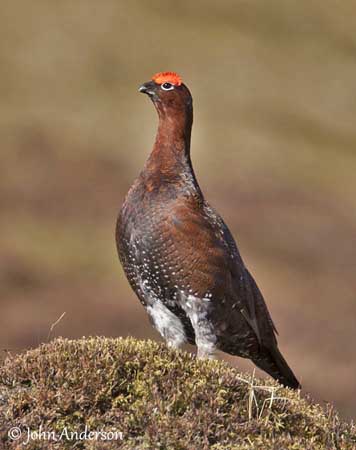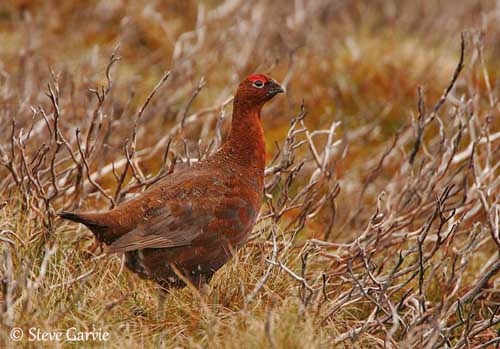
Fr: Lagopède d’Ecosse
Gallois: Grugiar, Grugiar goch, Iâr goch, Iâr y mynydd
Irlandais: Cearc Fhraoigh
All : Schottisches Moorschneehuhn
Esp : Lagópodo escocés
Photographers:
John Anderson
John Anderson Photo Galleries
Steve Garvie
RAINBIRDER Photo galleries
Text by Nicole Bouglouan
Sources:
HANDBOOK OF THE BIRDS OF THE WORLD Vol 2 by Josep del Hoyo-Andrew Elliot-Jordi Sargatal - Lynx Edicions - ISBN: 8487334156
THE COMPLETE BOOK OF BRITISH BIRDS – Written by “Royal Society for the Protection of Birds” experts - Préface de Magnus Magnusson - Michael Cady- Rob Hume Editors - ISBN: 0749509112
THE HANDBOOK OF BIRD IDENTIFICATION FOR EUROPE AND THE WESTERN PALEARCTIC by Mark Beaman, Steve Madge - C.Helm - ISBN: 0713639601
L’ENCYCLOPEDIE MONDIALE DES OISEAUX - Dr Christopher M. Perrins - BORDAS - ISBN: 2040185607
The IUCN Red List of Threatened Species
Arthur Grosset's Birds (Arthur Grosset)
Wikipedia, the free encyclopaedia
Red Grouse
Lagopus scotica
Galliforme Order – Tetraonidae Family
BIOMETRICS:
Length: 36-43 cm
Wingspan: 55-66 cm
Weight: M: 535-700 g – F: 525-650 g
DESCRIPTION:
Formerly classified as a subspecies of Lagopus lagopus, it is now considered to be a full species.
This species differs from other members of genus Lagopus by its reddish-brown plumage throughout the year, whereas other ptarmigans have all white winter plumage.

The Red Grouse has plump body. The adult male has reddish-brown plumage overall with pale-edged feathers and dark vermiculations. Head, neck and breast sides are more rufous.
On the underparts, white streaks and spots are more conspicuous than above, and mainly during winter. Legs and feet are covered in whitish feathers.
The short tail is blackish. On the upperwing, flight feathers are dark brown to blackish, whereas on the underwing, coverts are white with black markings.
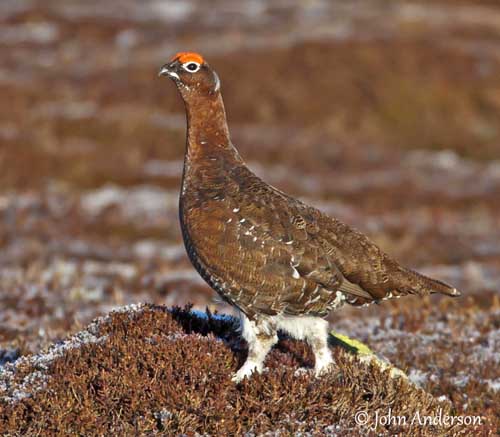
On the reddish head, the male shows bright red fleshy eye combs, more conspicuous during breeding season and displays. The dark brown eyes are surrounded by white eyering. The black bill is slightly hooked at tip.
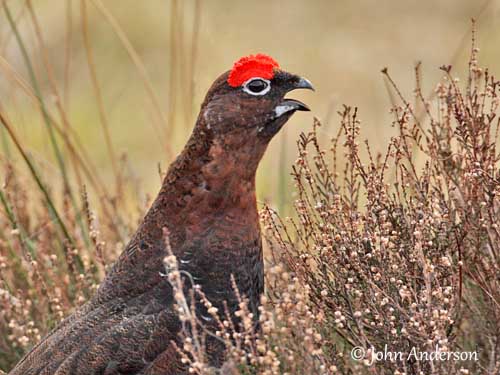
The female has almost similar plumage but duller and less reddish. She has smaller eye combs and her plumage appears more cryptic, with conspicuous scaled effect. During winter, the comb is lacking but she still has the white eyering.
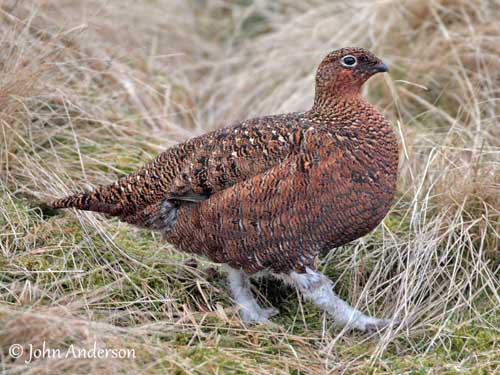
The juvenile is duller and lacks the eye combs. It can breed at one year old.
The chick has buff-white underparts and brownish cryptic upperparts. It has chestnut crown bordered with black line on each side, typical in Lagopus species.
VOICE:
The Red Grouse utters distinctive call, a series of explosive, rapid, guttural barking notes, often ending with something like “go-back-go-back-go-back…” when the bird is alighting.
Another call helps to identify the species, a series of “chut-chut-chut-chut…”
Other non-vocal sounds are produced by the whirring wings when the bird if flushed.
HABITAT:
The Red Grouse is usually found in treeless tundra and open upland heather moors, but it also frequents low-lying bogs and sometimes lower farmland during hard winters.
RANGE:
The Red Grouse is endemic to the British Isles and can be found in several parts of Scotland, Wales, England and Ireland, including the smaller islands off Scotland coasts such as Orkney, Shetland and Outer Hebrides.
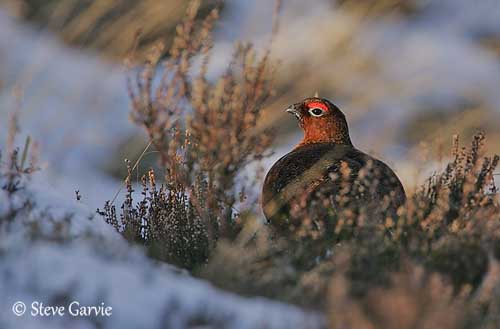
BEHAVIOUR:
The Red Grouse feeds on shoots of heather (Calluna vulgaris), seeds, berries, shoots and leaves of several other plant species, and insects during the nesting period.
It feeds from the ground and forages by walking and pecking, often beneath snow.
Insects are chick’s main food during the first days of their life.
The heather Calluna vulgaris has high nutritional value, involving better breeding success and high population density. This is the main food of the adults, and especially during winter.
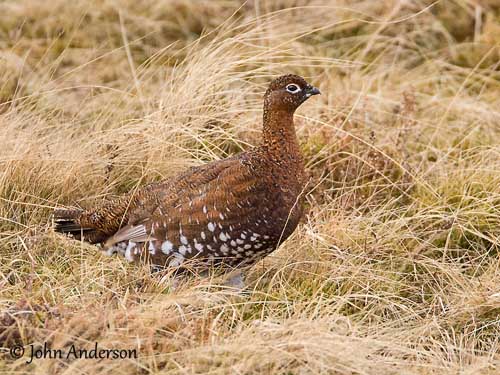
The Red Grouse is monogamous and strongly territorial. The territory is established as soon as the autumn. As the season is progressing, the male becomes aggressive and sometimes, violent attacks may occur. Visual and vocal signals are used by males competing for good territories, very important for better breeding success.
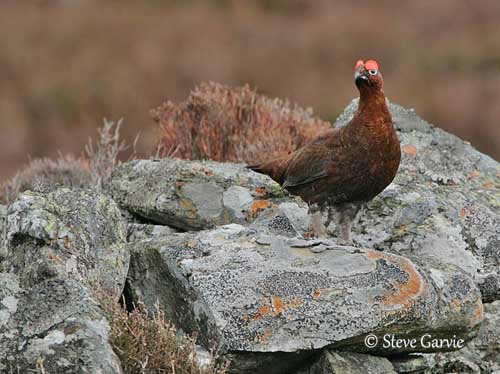
It also performs displays, leaping into the air, then gliding, and giving the typical “go-back-go-back-go-back…” when alighting. It adopts a posture with dropped wings and cocked and fanned tail. The combs are bright red and very conspicuous while it is strutting.
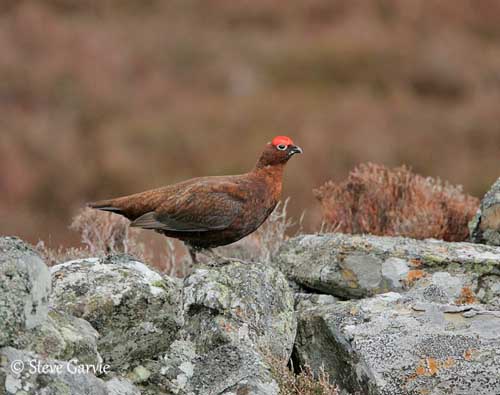
The territory is usually established in moorland area with heather and bilberry bushes where the female can make the nest.
The male often perches on prominent places or rocks at the boundaries to give advertising calls towards other males.
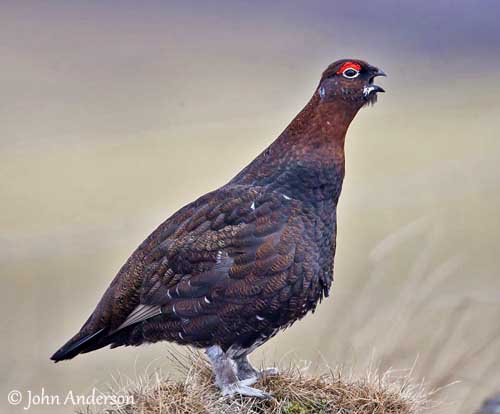
The Red Grouse is sedentary in its range, only performing short altitudinal movements.
FLIGHT:
The Red Grouse suddenly rises from the heather when disturbed and flushed. Then, it flies off with fast wingbeats producing a whirring sound.
Whirring flight and short glides are accompanied by cackling calls. The flight is straight and the bird usually flies low from the ground.
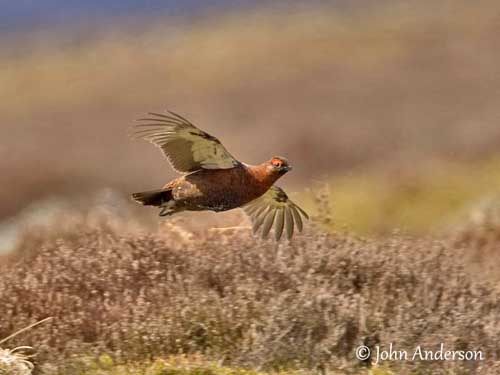
REPRODUCTION:
The breeding season occurs in April-May.
The Red Grouse’s nest is placed on the ground. This is a shallow scrape concealed in thick bush, often partially covered by the vegetation. This depression has thin lining.
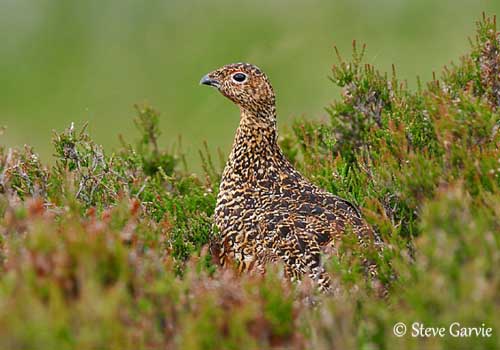
The female lays 6-9 creamy-white eggs with dark markings. The male usually guards the female while she incubates during three weeks. At hatching, the chicks have the typical chestnut crown bordered with black lines, and cryptic plumage.
Both parents feed them during six weeks and accompany the young birds. The juveniles are able to fly 13 days after hatching, in order to escape predators.
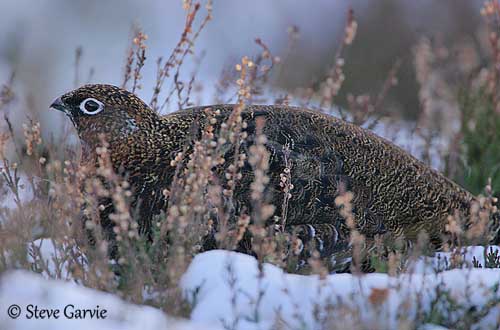
Both parents protect the young birds against foxes, crows and skuas according to the range. The adults may perform the “broken-wing” display to distract the predator.
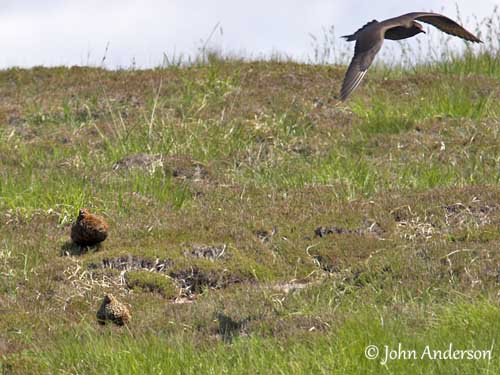
DIET:
The Red Grouse is mainly herbivorous, feeding primarily on shoots of heather (Calluna vulgaris), but also taking seeds, berries, shoots and leaves of several other plants, and insects during the breeding season.
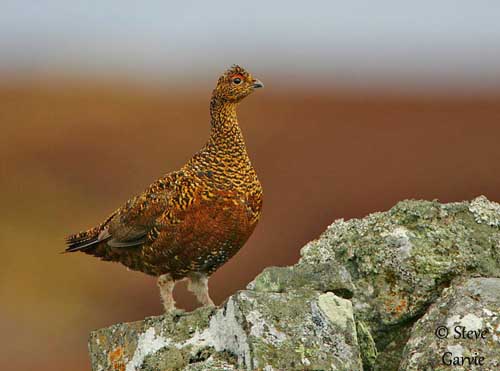
PROTECTION / THREATS / STATUS:
The Red Grouse is a famous gamebird, and during the shooting season, numerous birds are killed as part of moorland management’s programmes, usually without affecting the next breeding season.
The Red Grouse is endemic to British Isles and a natural product of the environment. Any release of captive birds to maintain the population’s density, involving the protection of suitable habitats, control of predators and shooting management.
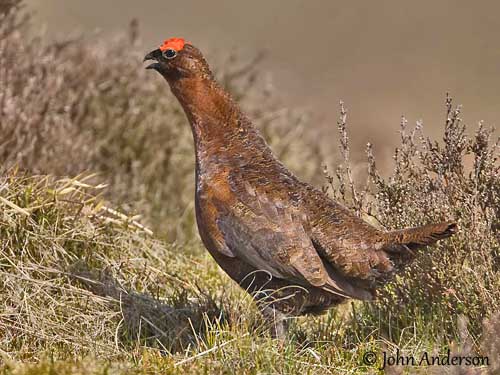
In spite of such controls and management, the populations are declining, probably due to changes in their preferred habitats with sheep and other wildlife slowly invading the moorlands.
However, the Red Grouse is not currently threatened and classified as Least Concern by IUCN Red List.
